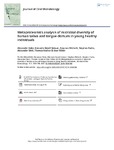Metaproteomics analysis of microbial diversity of human saliva and tongue dorsum in young healthy individuals
Rabe, Alexander
Salazar, Manuela Gesell
Michalik, Stephan
Fuchs, Stephan
Welk, Alexander
Kocher, Thomas
Völker, Uwe
Background: The human oral microbiome influences initiation or progression of diseases like caries or periodontitis. Metaproteomics approaches enable the simultaneous investigation of microbial and host proteins and their interactions to improve understanding of oral diseases.
Objective: In this study, we provide a detailed metaproteomics perspective of the composition of salivary and tongue microbial communities of young healthy subjects.
Design: Stimulated saliva and tongue samples were collected from 24 healthy volunteers, subjected to shotgun nLC-MS/MS and analyzed by the Trans-Proteomic Pipeline and the Prophane tool.
Results: 3,969 bacterial and 1,857 human proteins could be identified from saliva and tongue, respectively. In total, 1,971 bacterial metaproteins and 1,154 human proteins were shared in both sample types. Twice the amount of bacterial metaproteins were uniquely identified for the tongue dorsum compared to saliva. Overall, 107 bacterial genera of seven phyla formed the microbiome. Comparative analysis identified significant functional differences between the microbial biofilm on the tongue and the microbiome of saliva.
Conclusion: Even if the microbial communities of saliva and tongue dorsum showed a strong similarity based on identified protein functions and deduced bacterial composition, certain specific characteristics were observed. Both microbiomes exhibit a great diversity with seven genera being most abundant.

